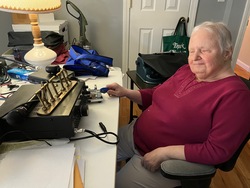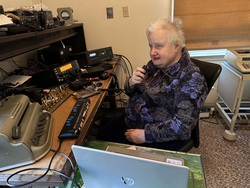 March 5, 2024 | |||||||||||||||||||||||||||||
From the Editor Thank you all who have opted to receive The NTS Letter. We hope you are enjoying it. We would like to hear more from you about what is going on in your areas - experiences in training, experiences in traffic deliveries, recruiting efforts, exercises and work with ARES, work with clubs, special recognition, etc. As we go into our second year, we, the NTS 2.0 working groups, are looking forward to hearing from anyone interested in the improvement and enhancement of NTS and traffic handling. If you would like to contribute to this project, please contact Fred Kemmerer, AB1OC, at ab1oc@arrl.org. It has been a great group to work with, especially knowing we have the support of ARRL. NTS 2.0 Update - Training Videos In last month's NTS Letter, we recapped some of the accomplishments of the NTS 2.0 working groups during 2023. There are other projects we continue to work on, but none so important as training videos. It is essential that we get more licensed amateurs to have the skill set to reliably relay message traffic. Because it appears that many today look to videos to learn about a variety of topics, we are currently creating a series of videos that we hope will be useful, particularly for the beginning traffic handler. There is much one can learn about successful message relay, and it can be somewhat daunting to check into a traffic net for the first time. We plan to start with the basics in short 5- to 15-minute videos on such subjects as the radiogram, checking into a net, and sending, receiving, and delivering traffic, which one can view in any order at any time. Once one gets the confidence to check in and handle traffic, they can go on to more advanced topics such as net controlling, net managing, and participation in emergency nets. We would like to hear from any amateur radio operators who have experience in creating and editing videos. If you can help us in this way, please contact Fred Kemmerer, AB1OC, at abloc@arrl.org. Treasure Hunt Update Hello, treasure hunters! Fifteen stations participated in the February NTS Treasure Hunt. The following stations successfully completed all three rounds:
The first three Treasure Hunt finishers in the inaugural NTS 2.0 Treasure Hunt will receive a specially designed mug courtesy of the NTS 2.0 planning committee. If you missed the official treasure hunt announcement in the December 2023 issue of The NTS Letter, here is a recap: This is a fun, on-air, multi-step competition in which you will respond to a "judge" with your answer to an initial clue or question via radiogram. The judge will reply via radiogram with the identity of the next judge, along with the next question or clue in the hunt. Are you ready? Here is the first question for our March 2024 contest: What are the four parts of the radiogram called? Send your answer via NTS radiogram to Jon W. McCombie, N1ILZ, Eastham, MA 02642. The text of the radiogram should consist of the words "TREASURE HUNT ROUND 1," followed by your answer. Be sure to form the NTS message properly, with the message number, the station of origin, and the correct check. You will receive a confirmation radiogram back with the next clue or question and addressee; or a message explaining that your answer is incorrect and to please try again. Please check out our survey to let us know how we are doing. Survey Link Radiogram Portal Update Testing has been completed and the Radiogram Portal has gone live! We are now seeking traffic handlers from across the country to apply to be appointed as official "Radiogrammers." A video that explains the process is now available on the nts2.arrl.org website, under the tab "Training and Documentation. Once an applicant has been approved, they will be given access to the portal to retrieve messages for formatting radiograms and entering into the traffic system via any of the various modes available. It is a fun activity, a way to originate third-party radiograms and introduce amateur radio and message handling to the public and fellow amateurs who have not heard of this activity. Check out the video on the website and follow the instructions. The Importance of Bulk Greeting Messages In December 2023, I attended a meeting at New England Sci-Tech, a STEM/Makerspace in Natick, MA. Also attending were: ARRL First Vice President Mike Raisbeck, K1TWF; Western MA ACC Larry Krainson, W1AST; and Eastern MA ACC Bruce Blain, K1GB. We were involved in planning the 2024 ARRL New England Division Convention. A young ham, Francesco Tron, KC1TTJ, of Wellesley, Massachusetts, also happened to be at New England Sci-Tech that morning.
The Makerspace leader interrupted us briefly and asked if Francesco could come in and show us something. Francesco walked in and proudly displayed a paper that he received via the US Mail from a local traffic handler. It was a "Welcome to Amateur Radio" message originated by Glenn Killam, VE1IJ, from Saint Alphonse, Nova Scotia. Francesco was beaming, excited to have received this simple message affirming his entry into the world of amateur radio. So, before you dismiss "Welcome to Amateur Radio" messages as unworthy of relay or delivery, please consider the impact that receiving this simple greeting had for this young amateur. I have no doubt that Francesco will treasure that piece of paper for a long time! -- Phil Temples, K9HI, Vice Director, New England From the E-Mailbox: Station ID - K9LGU WI STM Wisconsin Section Traffic Manager (STM) Denny Rybicke, K9LGU, includes a series of FAQs in his monthly reports. The following FAQ addresses something we don't often talk about, and yet it pertains to basic FCC regulations, namely Station ID. How does this apply to traffic nets? Denny writes the following: What's required for identification in nets? The FCC is clear about identification of amateur stations. Part 97.119 states "Each amateur station. . .must transmit its assigned call sign on its transmitting channel at the end of each communication, and at least every 10 minutes during a communication, for the purpose of clearly making the source of the transmissions from the station known to those receiving the transmissions. No station may transmit unidentified communications or signals, or transmit as the station call sign, any call sign not authorized to the station." So, what does that mean for traffic handling and net operation? It means during a net, a check-in identifies when first calling in, and at the end of a "second go," if any. When an NCS asks check-ins to say the NCS call first, that helps avoid doubling - but the FCC requirement is just to give yours at the end. Luckily, it doesn't mean each station must identify every 10 minutes during the net. If an operator establishes communication with another station off frequency to pass traffic, it's the same procedure - every 10 minutes and at the end of the communication. How about the net control? The net control station only needs to identify every 10 minutes and at the end of a series of transmissions with the net. True, it may help to identify the net and net control more frequently during the net operation, but it is only "required" every 10 minutes and at the "end of the communication" with the net. For example, at the end of a "second go," the net control does not have to say both the net member's call and their own although that is a polite recognition. The "goer" already should have identified. It may be nice to begin a transmission with our call sign, but it's not necessary as it is at the end. Technically, we do not need to say the call of the other station - just identify ours. If we spend too much time repeating call signs, we limit time for other content. We do not need the to become the "Department of Redundancy Department" with calls. Finally, we certainly don't have to say "For ID." Why else would we identify? -- 73, K9LGU, STM, Wisconsin Section Spotlight: The Twins - Betsey, K1EIC, and Barb, K1EIR Twin Hams Light Up the Airwaves: Meet Barb Lombardi, K1EIR, and Betsey Doane, K1EIC Twins Barb and Betsey were introduced to ham radio by their uncle Art, W1VGP, and got their Novice-class licenses in 1958.
Around 1960, they were introduced to traffic through the Mohawk Hudson Training Net. The first message they sent had a check count of 85! Barb and Betsey still laugh about that. One of their local ham friends, Bill, K1AQB, now in Nevada, mentored them in traffic handling. They soon became involved in the Connecticut Phone Net (CPN) and the Connecticut CW net (CN). Both receive traffic using Braille writing equipment. Barb became Route Manager for CN (that is what it was called then) and they held meetings in the fall on Friday nights. At one such gathering, it was noticed that Barb had her hands on the table as a CW op would, and Betsey's were in her lap. Both nets held a dinner each spring. Over 60 people would attend. The twins' biggest adventure occurred when in conjunction with the 1985 Mexico City earthquake. ARRL gave a local TV station their phone numbers, leading to local phone circuits being tied up with many calls from the public. The twins handled a tremendous number of health and welfare messages. Betsey, K1EIC, served as Connecticut Section Manager for over 20 years and helped coordinate ham radio activities at the Eastern States Expo for several years.
She was also involved in coordinating the Special Olympics in New Haven. Betsey and Barb handled lots of traffic and helped with the training exercise through Red Cross and FEMA in New London. For 25 years, Betsey ran the K1EIC and W1HAD NTS packet nodes consisting of eight nodes at two different physical locations. During the Gulf War, Betsey handled traffic from the USS Kennedy on AMTOR. Betsey served in Navy-Marine Corps MARS as NNN0EBP. She earned the Chief's Commendation for the proper formatting of an emergency message. Professionally, Barb and Betsey both hold two master's degrees. Betsey is a retired math and computer science professor, and Barb is a retired substance abuse counselor. While traffic has slowed down, both still enjoy it very much. Barb and Betsey are active in local, Section, and area nets, as well as Transcontinental Corps. As Barb says, "CW forever!" NTS Resources The National Traffic System® (NTS) is a network of amateur radio operators who move information during disasters and other emergencies. General messages offering well wishes also move through the NTS to help test the system and to help amateur radio operators build traffic handling skills. While the NTS is primarily set up to serve the United States and Canada, it is possible to move traffic internationally through the NTS through various local, regional, area, and international network connections.
Sign up to Receive The NTS Letter The NTS Letter is published monthly and is free of charge to ARRL members. Subscribe: arrl.org/opt-in-out Editor: Marcia Forde, KW1U, Section Traffic Manager -- Eastern Massachusetts, Western Massachusetts, and Rhode Island ARRL Director of Emergency Management: Josh Johnston, KE5MHV Support NTS: Join ARRL NTS is a program of ARRL The National Association for Amateur Radio®. No other organization works harder than ARRL to promote and protect amateur radio! ARRL members enjoy many benefits and services including digital magazines, e-newsletters, online learning (learn.arrl.org), and technical support. Membership also supports programs for radio clubs, on-air contests, Logbook of The World®, ARRL Field Day, and the all-volunteer ARRL Field Organization.
| |||||||||||||||||||||||||||||
.jpg)








